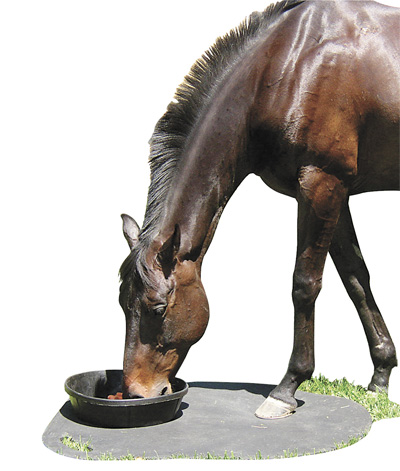
Healthy as a Horse
The desert and your horse: Sand Colic
By Hannah Blackman, DVM | August 26, 2009
 If you have had a horse colic here in Arizona, you may have seen your veterinarian put manure in a rectal sleeve with some water and hang it up. This wasn’t just a new decoration for your barn. Your veterinarian was looking for sand, which will settle into the fingers of the glove and is a good indication if there is sand in your horse’s intestines. Sand is in your horse’s environment and is ingested when they eat, or some horses (especially foals) deliberately eat sand.
If you have had a horse colic here in Arizona, you may have seen your veterinarian put manure in a rectal sleeve with some water and hang it up. This wasn’t just a new decoration for your barn. Your veterinarian was looking for sand, which will settle into the fingers of the glove and is a good indication if there is sand in your horse’s intestines. Sand is in your horse’s environment and is ingested when they eat, or some horses (especially foals) deliberately eat sand.
Ingested sand that is coarse will settle in the right colon, transverse colon, and pelvic flexure and fine sand will usually accumulate in the ventral colon. A sand impaction may be palpable by your veterinarian. Sand may also be detected by listening with a stethoscope to the lower abdomen. If there is sand it will sound like waves on the beach. Sand may also be visualized on radiographs of the abdomen.
With sand colic and sand impactions, the horse usually has mild to moderate signs of colic pain. Some horses will have a decreased appetite and decreased manure output. They may show colic signs intermittently for a few days or weeks prior to diagnosis. Mild signs of colic include lying down more often (but quietly without rolling), looking at the sides, etc. Some horses even have diarrhea from the irritation of the sand. If you do notice your horse acting colicky, call your veterinarian.
The most common treatment is using psyllium at 2-3 times the manufacturer’s dose for a month to remove the sand. This should only be done while working with a veterinarian after an obstruction has been ruled out. After the month, a preventative dose is resumed (standard dose is once daily for 7 days, once a month). Other options include mineral oil, which may just go around the sand without moving it; or magnesium sulfate, which can break up a sand impaction but requires multiple treatments by your veterinarian.
The prognosis for recovery is usually very good. The poorest prognosis is when a very heavy sand burden is present and the colon is devitalized. Surgery may be required to remove large amounts of sand if other methods are not effective, or if the horse is in a lot of pain.
Prevention of sand ingestion is the best treatment. There are some simple things you can do to limit the amount of exposure to sand. One way is to feed horses off of the ground such as in a feeder or hay bag and clean the feeder regularly of any sand that accumulates. Stall mats where horses spill feed that are swept regularly will decrease the amount of sand ingested as will placing a muzzle on the horse for turn out.
It is also important to ensure that your horse has plenty of roughage (hay) as this will help decrease the search behavior that leads to ingestion of sand. The fiber in the hay is also very important in pushing material through the intestine. If you are lucky enough to have horses that graze on pasture, rotating pastures regularly will help decrease the risk of sand colic.
Sand colic is something all horse owners should be aware of especially here in the desert.
Chaparral Veterinary Medical Center is a full service veterinary hospital and clinic for horses, dogs, cats, and exotics. They offer not only quality primary care services but also provide specialists for the most demanding equine referral cases. Please visit cahosp.com.

